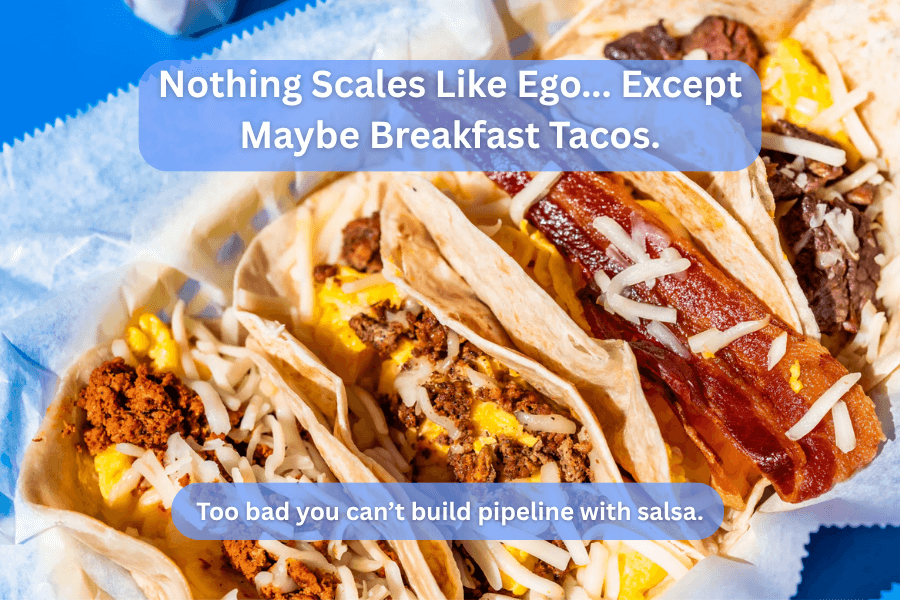- What is the “founder ego trap” in go-to-market?
- How do I know if I’ve fallen into the founder ego trap?
- Can you scale a business without removing the founder from sales?
- Why doesn’t just hiring more salespeople work to scale?
- What’s the cost of not fixing the founder ego trap?
- TL;DR
- Intro – The Founder Ego Trap
- What is the “Founder Ego Trap”?
- What are the signs of the Founder Ego Trap?
- What happens when you don’t fix it?
- How do you fix it without losing your edge?
- What does the better path look like?
TL;DR
Founder ego is one of the biggest blockers to building scalable sales systems. This post shares a firsthand account of what happens when a company relies on hustle instead of go-to-market process—and how ego-driven leadership undermines sales teams, rep performance, and long-term growth. Learn how to escape the founder ego trap by building a repeatable, buyer-focused GTM engine that enables others to close—without burning out or bottlenecking growth.
Intro – The Founder Ego Trap
“He bought tacos… for himself.”
That’s what my rep said as she quietly shut the conference room door and joined our Zoom.
I’d been waiting for our weekly sales meeting to start. I could hear noise in the background—laughter, applause, paper plates rustling. Something was off.
He looked uncomfortable. Then he told me what happened.
The CEO had just walked into the office with a bag of breakfast tacos, gathered everyone around, and announced that he’d closed a big deal.
Then came the punchline:
“I bought these tacos for you,” he told the team.
“…but not because of anything you did. Because, I closed the deal.”
No mention of the salesperson who sourced and worked the deal.
No mention of the process we’d been building from scratch.
No recognition of the months it took just to rebuild a broken pipeline.
Just a self-congratulatory mic drop.
And the kicker?
That was the first new deal they’d closed in nearly two years.
Let me rewind.
I had very recently joined the company as Sales Director for what was generously still being called a “startup”—ten years in, and still no sales infrastructure.
The three reps I inherited had less than three years of combined experience. One was fired right as I joined. The second never lifted a finger. I had to fight for weeks just to get the CEO’s permission to let them go. The third had potential—smart and coachable—but no training, no structure, and no clue where to start.
We had a CRM…but it was some obscure, bottom-of-the-barrel tool filled with junk data and imaginary deals. It was theater. A pipeline of ghost stories.
So I ripped it out, replaced it with HubSpot, and started clean.
No pitch deck.
No messaging.
No sales collateral.
No idea why customers said yes—or why most said nothing at all.
The only deals that had ever closed came straight from the CEO’s charm and personal network. And as I quickly learned, that wasn’t just his preference—it was his identity. His ego was the system.
But charm doesn’t scale.
So I rolled up my sleeves and got to work:
- Cleaned the CRM
- Built real outbound
- Defined a basic ICP
- Started tracking and qualifying real opportunities
We finally had a few real deals in the pipe… 3x bigger than anything they’d seen before. But when one hit a snag, the CEO stepped in, went rogue, and closed it on his own.
Then he threw himself a taco party to celebrate the company’s first deal in two years.
Two weeks later, I was gone.
This is the ego trap. And it’s more common than you think.
Founders (and even seasoned CEOs) who’ve won deals on hustle alone often can’t stomach what it takes to build a system. They crave control. They trust themselves but not the team. They hire salespeople but don’t enable them. They demand results, but won’t invest in the process that produces them.
And the GTM Engine? It feels too slow. Too methodical. Too different from what they know.
In this article, we’ll break down:
- What the ego trap really looks like
- How it shows up in your team and pipeline
- Why it kills growth, morale, and scalability
- And how to replace it with something stronger: empathy, structure, and repeatability
Let’s get into it.
What is the “Founder Ego Trap”?
It starts with a belief that seems harmless—even necessary.
“No one knows this product like I do.”
“I just need to push harder.”
“I’ll hire someone once there’s a system.”
But here’s the twist: the system never gets built.
That’s what happened in the company I joined as Sales Director. It had been around for 10 years but still called itself a startup. There were no sales playbooks. No messaging assets. The CRM? A cheap, unfamiliar tool full of ghost pipeline deals and bad data. We ripped it out and started over with HubSpot—just one step in a long list of cleanup efforts.
I inherited a team of three reps—bright but wildly inexperienced. One had already been fired. Another never did the job and always had an excuse. The third had potential but zero structure to work with.
The CEO, meanwhile, ran on ego. Every deal in the company had been closed by him or the previous sales leader, not because of any repeatable process, but through raw grit and personal charisma.
He didn’t document a single thing.
He didn’t believe in sales enablement.
And he expected me to “figure it out” and work the same magic he did—with none of the tools.
As Entrepreneur put it:
“The need to control everything stifles growth. Eventually, your refusal to let go becomes the ceiling your team can’t break through.”
— The Founder’s Ego Is Killing Your Startup
This is the Founder Ego Trap—where success becomes its own bottleneck.
Instead of investing in systems, founders rely on hustle.
Instead of building a team that can scale, they build a pedestal only they can stand on.
And when that hustle stops working… so does the business.
What are the signs of the Founder Ego Trap?
It’s easy to miss when you’re in it. Ego doesn’t always look like arrogance. Sometimes it looks like “ownership.” Sometimes it hides behind a sense of duty or martyrdom.
Here’s how it shows up in the go-to-market org:
🚩 1. The founder is still the best (or only) closer.
The whole sales team orbits them. Every big deal gets routed back to the top. Reps are hired, but quickly become assistants—not sellers.
“Founders who micromanage GTM teams often think they’re ‘protecting quality,’ when in reality, they’re stalling organizational learning.”
— OpenView: Why Founders Need to Let Go to Scale
🚩 2. No sales documentation or onboarding plan.
If the go-to-market system lives in the founder’s head, new hires will flounder. No pitch deck, no discovery process, no ICP guide, no case studies = no leverage.
“Without a system to teach and transfer knowledge, even great hires can’t succeed.”
— Harvard Business Review: Why Sales Training Fails
🚩 3. Salespeople are hired before the system is.
This is the most expensive sign. Instead of building a foundational GTM engine, founders throw headcount at the problem—hoping the right rep will magically “just get it.”
And when it doesn’t work?
They fire the rep… and try again.
One study by Pavilion found that:
“The average first VP of Sales tenure is 19 months, and the cost of a bad hire at that level can exceed $1 million in lost productivity, pipeline, and morale.”
— Pavilion: State of the VP of Sales
The trap is subtle:
Founders think they’re being efficient. But by skipping process, they end up spending more—on failed hires, missed revenue, and lost time.
What happens when you don’t fix it?
The short answer?
You burn out. Your team burns out. And your growth plateaus.
That’s what happened at the company I joined.
Despite finally getting a few large deals into the funnel—real enterprise conversations—the CEO couldn’t let go.
He couldn’t see the early wins because they didn’t come from him.
He couldn’t see the pipeline because it wasn’t yet revenue.
And he couldn’t see the point of the structure I built because it didn’t immediately match his pace of charm-fueled wins.
So when one deal slipped a quarter, and another went to a competitor, he panicked.
Then came the tacos.
He closed a deal—one that had started with my rep—and excluded us completely.
No acknowledgment. No team support. Just a loud victory lap and free tacos for the office… celebrating the first new deal in nearly two years.
The message was clear:
“You’re all replaceable. I’m the rainmaker.”
A couple weeks later, I was laid off.
This isn’t just a leadership problem. It’s a go-to-market system failure.
When a founder can’t release control:
- The team loses confidence
- Sales cycles become inconsistent
- Deals fall through cracks
- No one learns how to repeat success
Eventually, you end up running harder just to stay in place.
“Founder-led sales can get you from 0 to 1. But to get from 1 to 10, you need systems, stories, and scalable training.”
— Michael Schiltz, The GTM Engine
And that system doesn’t emerge from hustle.
It’s an intentional investment in empathy, enablement, and buyer-first design.

Want the Blueprint to your own GTM Engine?
Get the e-book that lays it all out. Dig deep into the pitfalls that startups typically fall into and the ways to avoid them. Learn how to incorporate empathy, insights, storytelling and consistent process to create predictable and scalable revenue.
How do you fix it without losing your edge?
The goal isn’t to sideline yourself.
It’s to build a machine that lets your impact scale beyond you.
Here’s how to start:
🛠 1. Get the system out of your head
Founders often underestimate how much they know—and how little of it’s documented. Start with:
- A clear Ideal Customer Profile (ICP)
- The real reasons customers buy (Voice of Customer research)
- The top 3 sales stories every rep should know
Even a lightweight GTM One-Pager can help turn intuition into repeatable motion.
“If it’s not documented, it doesn’t exist.”
— Sales Assembly: Why Sales Enablement Starts with the Founder
🎯 2. Stop selling features—start telling stories
Founders who convert consistently do one thing better than anyone else:
They make prospects feel understood.
They don’t just explain what the product does.
They walk buyers through a story:
- What pain they had
- What it cost them
- How the product changed things
- What unexpected gain came after
Storytelling isn’t fluff—it’s clarity wrapped in emotion.
“Facts tell, but stories sell. They create connection, build trust, and make your message stick.”
— Kindra Hall, Stories That Stick
🧭 3. Use outside help to build the GTM engine
You can’t build while you’re buried in the weeds.
This is where a third party—someone who isn’t stuck inside the day-to-day—can map your buyer journey, refine messaging, and build the training and tooling your team needs to scale without guesswork.
That’s what I do.
Not just strategy—but building the discovery call guides, story decks, email campaigns, VoC-aligned pitch frameworks, and the full Champion Package to help your team win without needing you in every room.
You don’t need to stop being the closer.
You just need to stop being the only one.
Ready to find out more?
Schedule a discovery call with me to discuss the challenges and milestones in your organization and how I can help.
What does the better path look like?
The founders who scale past this founder ego trap aren’t the ones with the biggest egos.
They’re the ones who learn to let go.
They realize that building a go-to-market engine isn’t about replacing themselves.
It’s about multiplying themselves.
Here’s what that looks like:
✅ Sales reps who understand the customer pain, not just the product
✅ Discovery calls that sound more like therapy than pitching
✅ Messaging that aligns across marketing, outbound, decks, and demo
✅ A pipeline that isn’t fake optimism—it’s real, trackable momentum
✅ Wins that don’t require the founder’s fingerprints on every deal
Instead of playing hero on every call, the founder becomes the architect of a system that wins with or without them.
“True scale happens when your team carries your conviction—without needing your presence.”
— The GTM Engine
And for investors?
This is where the compounding starts.
When GTM becomes predictable, valuation multiples follow.
“Companies with structured sales processes see 18% more revenue growth than those without.”
— Harvard Business Review
What is the “founder ego trap” in go-to-market?
The founder ego trap happens when a founder relies solely on their own charm, hustle, and instinct to drive sales—without building the systems, processes, or messaging others need to succeed. It often leads to burnout, stalled growth, and expensive hiring mistakes.
How do I know if I’ve fallen into the founder ego trap?
If you’re still closing every deal yourself…
If new hires underperform because they “don’t get it”…
If your sales enablement materials live in your head…
You’re probably in the trap.
Can you scale a business without removing the founder from sales?
Absolutely. The goal isn’t removing the founder—it’s reducing dependency on them. When the founder’s insights are translated into a repeatable GTM system, sales can scale without losing the authenticity or conviction that made early wins possible.
Why doesn’t just hiring more salespeople work to scale?
Because headcount without enablement is just overhead. If your salespeople don’t have a clear ICP, a compelling message, buyer-aligned collateral, and proper coaching—they’ll churn fast or miss quota. That’s why systems matter more than hustle.
Bonus stat: “The average first VP of Sales only lasts 19 months.”
— David Sacks, Craft Ventures
What’s the cost of not fixing the founder ego trap?
Missed revenue, failed hires, and founder burnout.
You’ll lose deals to more structured competitors.
And investors will see it in your metrics.


Leave a Reply